

GROTTE DE MOTIERS - Juny 2008
After having spent a couple of enjoyable
days at the Congress of Cave Diving in Saint-Nazaire-en-Royans, I transfer to
Switzerland for the exploration of the second sump in the cave of Môtiers.
The cave was explored by Jean-Jacques
Bolanz as far back as 1985, to the depth of -102m. At that time, diving on open
circuit was certainly more tiring than today's diving on closed circuit. At the
end of the dive, it was necessary to transport all of the cylinders used out of
the cave to refill them, while today it is sufficient to replace the filter and
the two small 3lt. cylinders from the rebreather. Years later, when Jean
Jacques began to use the new machines, he was stimulated to continue the
exploration using both the semi-circuit “Recy” and the closed-circuit “Voyager”,
but different problems that cropped up prevented him from doing so. Now it's up
to me to follow his guide line.
Monday, June 2 time flies, while I evaluate
what equipment I would need for the exploration and then I store it adequately
in the caving sacks ready to be carried into the cave. There would only be seven
willing participants who would help me with the transportation, therefore I
carefully choose just the indispensable materials among those available.
At 17.00 I am in the parking area near the
cave, where also the other cavers arrive promptly on time. Greetings and
presentations, then we set off towards the cave, which is five minutes on foot
from there. We cross a short stretch of plain, then a few dozen meters up a
steep path until we arrive at the foot of a magnificent waterfall, on the left
of which is the entrance to the cave.
The cave of Môtiers, developed in the
limestone massif of Travers, shows us all its geological grandeur, but not only
this, it can also be connected with the story of an earlier past, witnessed by a
plaque in memory of Jean Jacques Rousseau which was put on the boulder that lies
at the entrance of the cave. It seems that the writer had spent a few days
seated at the foot of the waterfall to draw up his Lettres écrites de la
Montagne. Published in 1762, his two major works were banned both by the
Parisian Parliament and by the Council of Geneva and thereafter they were also
indexed by the Church. So, to avoid arrest, Rousseau escaped to the Prussian
principality of Neuchâtel and once he had obtained political asylum, remained in
the town of Môtiers.
To penetrate into the bowels made of sump
waters of the cave of Môtiers, we have to cross a dry area of about half a
kilometre. Each of us carries a sack on his back containing the cylinders, the
regulators, the reel, the lights, etc.. We move on into the large tunnel, which
slightly rises at first, and then walk along a horizontal stretch where we pass
our first narrow passage, through which I can barely move, because of the closed
circuit "Copis” on my back. We climb a small wall helped by a rope which has
knots at regular intervals, then continue along a horizontal stretch up to a
second restriction. There, I am forced to take off the "Copis" and ask for help
to get it through the narrow passage. Then we reach the "Lake of Mud" which has
this name because it is a stretch of gallery thirty metres long characterized by
a floor which is completely covered by mud and which is ready to swallow up
boots, socks, gloves and anything else which can be dropped by the unlucky
adventurers. I hesitate for a moment before putting my feet into the muddy lake
and as soon as I advance, I sink up to my knees in the mud. Loaded with the
rebreather and even with the boots which were a size too big for me, it is a
daunting task to free myself from that mud trap. At last I manage to go back a
couple of meters and, once out of that unfortunate situation, I decide to cross
the tunnel from the opposite side, which seems more solid to me. The correct
choice. Finally we reach our destination: the first sump. The entrance pool is
calm and inviting, it seems to be waiting for someone to make a ripple.
Unfortunately, the clay also covers the slide like point of access, so it is not
is difficult to imagine that the visibility would be impaired once I entered the
water. I arrange all the equipment for the following day’s dive and foreseeing
that I would have little time at my disposition, I prepare everything ready for
immediate use. I remove the protection covering the individual pieces and
assemble them, being careful not to allow mud to enter inside either the
cylinders’ valves or the primary regulators. Then I test the rebreather: link
the two oxygen and trimix cylinders together and carry out all the checks
necessary to verify that nothing was broken during their transport. My "Copis"
is completely covered in mud but intact. At the end I am satisfied because I
managed to pack all the equipment necessary for deep diving in just eight sacks,
one for each of us, even if not all of them are of equal weight: Altogether, we
brought two 20lt.cylinders, one 15lt., two 10lt. and two 3lt., their own
regulators, one reel for the progression and one for security, the lights and
other small accessories. It’s time to go back and the return journey is much
faster because we have nothing to carry. After leaving the cave, we descend to
the river to rinse our suits, then we all drink a beer for friendship and
solidarity.
On Tuesday, there are only three of us, but
this is not a problem because the only things we have to carry are the suits and
the warm under suits. Being light, our progress to the sump is fast. All goes
smoothly until we arrive at the siphon, where we are face with a bitter
surprise: the water level has risen by around 1.5 m.
Patrick knows that, if the water rises any
further, it could close the narrow passage, the lowest in the cave, trapping us
inside. What’s more the weather forecast for the following day is not promising
and foresees heavy rain. So we decide that I would do just one reconnaissance
dive.
I lay a cloth on the ground to keep my feet
clean while I am dressing and, when I am ready, I head for the water. I walk
across some clay that sucks at my feet and then let myself slip into the mirror
of water. José hands me my fins and the 3 stage cylinders which are filled with
different gases: a 20lt. containing a 13% oxygen and 80% helium mixture and two
ten litres, one loaded with 35% oxygen and 35% helium and the other of pure
oxygen. I had chosen the gases according to the size of the cylinders in order
to be quicker and more agile underwater. In a moment I disappeared below the
surface.
I initiate my progression laying a new line
that would later be needed for the topography. The visibility is not good: it
varies from zero in the first few meters, up to about one meter and a half
throughout the rest of the dive. Inside the galleries, the rocks are covered in
clay. If I had breathed with an open circuit, the clay on the ceiling could
have fallen onto me. Fortunately I am using a closed circuit.
The first sump descends gradually to the
depth of -30m., continues horizontally for a few meters and then begins to climb
almost vertically to reach the surface after about 160m.
In this type of cave it is more comfortable
to carry out the exploration when the water level is high, so when the end of
the first siphon is reached you are not obliged to climb up out of the water
wearing all the equipment, to get to the second siphon. On this occasion there
is even too much water, but despite this my progression is easy.
I therefore reach the second siphon without
effort, passing the shallowest point which is at -3m. The cave changes
morphology and suddenly I am in front of a fracture that descends with a steep
slope. I follow Jean Jacques’ old line when, at around -30m, I see that it
leaves the large area to penetrate into a narrower one. I follow it for a few
more meters, but when the passage gets too narrow, I swim back to test another
hole that I can see which is lower and seems easier to pass. Indeed, I descend
and progress without difficulty. Further on, I find the line again and continue
to follow it down to about -43m. There I ascend a couple of metres and find a
new restriction. I must fix the line firmly to their appropriate points because,
in fractures of this type, if the line is not secured correctly, I could have
some unpleasant surprises when I come back.
Once that obstacle has been passed, the
fracture becomes generous in its dimensions, which favours my progression. I
quickly reach the depth of -61m., 290m from the entrance. I decide to stop
there, after diving for 30’. The choice is dictated by my lack of knowledge
concerning the water system of this cave, therefore I distrust remaining inside
it for too long. Even if I have a considerable margin of air autonomy to safely
continue my progress, the limit of the dive is determined by an unavoidable
factor: that of the weather. I cut the line, leaving a tail fifty centimetres
long, so that I can easily attach my line again when I would next return, and
then begin my re-entry.
Once I reach the first sump, I do a little
cleaning of the route by removing over 150m of old lines. I surface again in a
now turbid entrance pool after an hour of diving, I hand the equipment to my
companions and once out of the water, analyze the future of the exploration with
the others. According to the knowledgeable opinion of Patrick it would be better
to postpone a new dive for a few days and wait for the weather to stabilize.
While Josè and Patrick pack up the material
to carry out of the cave, I rest a while sitting in a muddy corner, with the
“Copis” still on my back. Since the water temperature was 7 °, I begin to feel
the cold accumulated during the dive, and I start to shiver. “Not too bad” I
think to myself “I’ll soon warm up walking back with the “Copis” on my
shoulders. On my return, in fact, as if by magic, the cold becomes warm, and the
warm becomes hot, and finally, after having overcome all the restrictions
carrying my “Copis”, I sweat.
The icy cold waterfall, which is located outside the cave, is
very good for a quick rinse of the equipment which is then cleaned meticulously
in the river removing all the clay and dirt accumulated during the time spent
in the cave.
| |
|
|
|
|
| |
 |
|
 |
|
| |
The material is ready for the transport
Photo: Patrick Deriaz |
|
The easy-to-walk tunnel
Photo: Patrick Deriaz |
|
| |
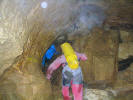 |
|
 |
|
| |
The easy-to-walk tunnel gets a little tight
Photo: Patrick Deriaz |
|
The narrowest point which we passed
Photo: Patrick Deriaz |
|
| |
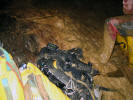 |
|
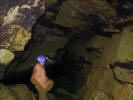 |
|
| |
The Copis after the transport
Photo: Patrick Deriaz |
|
...there it is the sump
Photo: Patrick Deriaz |
|
| |
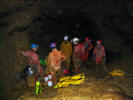 |
|
 |
|
| |
A little chat before turning back
Photo: Patrick Deriaz |
|
Who
knows what they are looking at...
Photo: Patrick Deriaz |
|
| |
 |
|
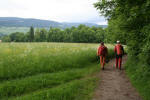 |
|
| |
How not to look at a waterfall like this?
Photo: Patrick Deriaz |
|
On the way approaching
Photo: Patrick Deriaz |
|
| |
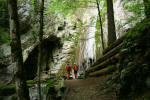 |
|
 |
|
| |
Today there are only three of us
Photo: Patrick Deriaz |
|
The route in the air filled part of the cave
Photo: Patrick Deriaz |
|
| |
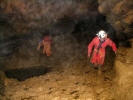 |
|
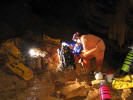 |
|
| |
Quick crossing of the mud lake
Photo: Patrick Deriaz |
|
Last pieces are assembled
Photo: Patrick Deriaz |
|
| |
 |
|
 |
|
| |
The
Copis slightly full of mud
Photo: Patrick Deriaz |
|
A
plastic sheet for protection against the mud
Photo: Patrick Deriaz |
|
| |
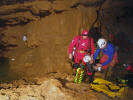 |
|
 |
|
| |
The gearing-up continues
Photo: Patrick Deriaz |
|
A little help
Photo: Patrick Deriaz |
|
| |
 |
|
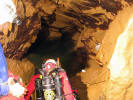 |
|
| |
Last arrangements
Photo: Patrick Deriaz |
|
The
descent to the sump
Photo: Patrick Deriaz |
|
| |
 |
|
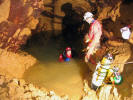 |
|
| |
The
descent into the sump
Photo: Patrick Deriaz |
|
The
return in cold choccolate
Photo: Patrick Deriaz |
|
| |
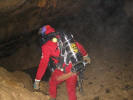 |
|
 |
|
| |
We start to transport the material back towards the exit
Photo: Patrick Deriaz |
|
The fatiguing mud lake
Photo: Patrick Deriaz |
|
| |
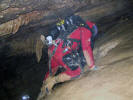 |
|
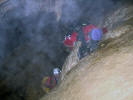 |
|
| |
A
little descent
Photo: Patrick Deriaz |
|
One
more step and...
Photo: Patrick Deriaz |
|
| |
 |
|
 |
|
| |
The narrow section begins
Photo: Patrick Deriaz |
|
Begin of the narrow section as seen from inside
Photo: Patrick Deriaz |
|
| |
 |
|
 |
|
| |
Exit of the section part
Photo: Patrick Deriaz |
|
Second narrow section
Photo: Patrick Deriaz |
|
| |
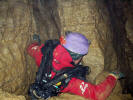 |
|
 |
|
| |
This one also is passed with the Copis on the back
Photo: Patrick Deriaz |
|
As ascent
Photo: Patrick Deriaz |
|
| |
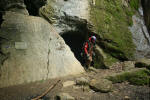 |
|
 |
|
| |
There ist is…the sunlight that’s not there
Photo: Patrick Deriaz |
|
A well deserved shower
Photo: Patrick Deriaz |
|
| |
 |
|
 |
|
| |
The position is not the most comfortable one
Photo: Patrick Deriaz |
|
Josè cannot take advantage
Photo: Patrick Deriaz |
|
| |
 |
|
 |
|
| |
Undisturbed I continue with the cleaning of the equipment
Photo: Patrick Deriaz |
|
The water of the stream is icy
Photo: Patrick Deriaz |
|
| |
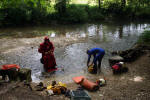 |
|
|
|
| |
In
the river finishing the cleaning of the equipment
Photo: Patrick Deriaz |
|
|
|
| |
|
|
|
|